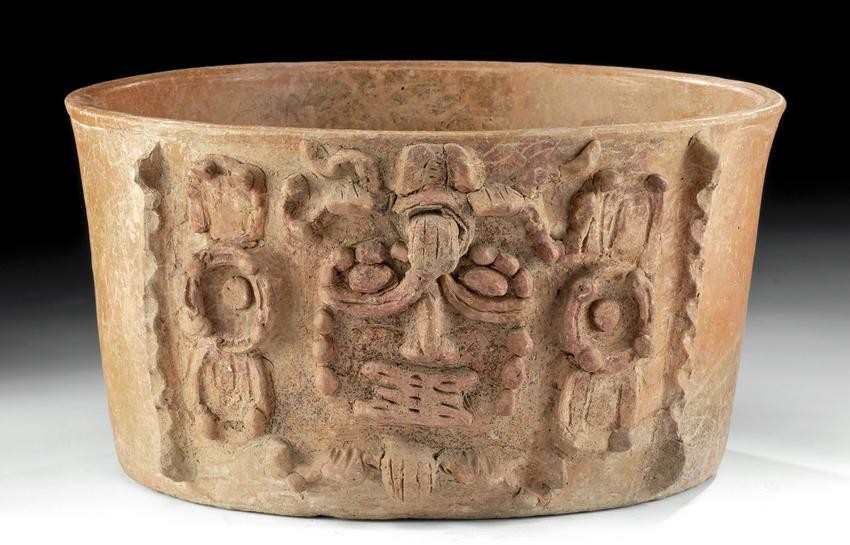Maya Pottery Cache Vessel w/ Abstract Portrait
Pre-Columbian, Southern Mexico to Guatemala, Maya culture, Classic period, ca. 4th to 6th century CE. A sizable cache vessel built by hand from orange-red pottery with a slightly concave base, tall walls that gently expand outward, a thick rim with a lip overhanging the exterior, and a deep basin with a shallow central kick. The front bears an abstract anthropomorphic countenance - perhaps representing a trophy head - with almond eyes, a slender nose with flared nostrils, a broad mouth with a dozen petite slits, hemispherical ear spools with four petite ornaments, and an intricate headdress with a projecting central 'tongue.' Remains of red pigment are visible across the face, and traces of black negative-resist motifs are scattered within the basin. Size: 10.75" Diameter x 5.75" H (27.3 cm x 14.6 cm)
Unlike many other ancient civilizations, the Maya did not have cemeteries or necropoli. Instead, they buried human remains with ritual caches of pottery filled with offerings of jade, beads, and other precious items throughout the landscape in which they lived. Scholars posit that these caches were perceived as 'earth offerings' as they have been found buried in and around architectural structures as well as some being found in floors, in the fill of buildings, or even set into walls. These caches may have been used as dedications for newly built structures, markers for the end of a building's use, or some type of renewal ceremony relating to the broader concept of Maya cosmology and its relation to the natural agricultural cycle. Cache vessels like this example were typically sealed with form-fitting lids to protect the interred contents.
For a stylistically similar example with an accompanying lid, please see The Denver Art Museum, object ID 1998.423A-B.
Provenance: private New York, USA collection, acquired around 1966
All items legal to buy/sell under U.S. Statute covering cultural patrimony Code 2600, CHAPTER 14, and are guaranteed to be as described or your money back.
A Certificate of Authenticity will accompany all winning bids.
We ship worldwide to most countries and handle all shipping in-house for your convenience.
#152715
Condition Report: Original lid missing. Repaired from multiple pieces, with restoration along areas of base, walls, and face, and resurfacing and overpainting along new material and break lines. Abrasions and minor nicks to rim, walls, basin, face, and base, with fading to original pigmentation and negative resist motifs, softening to some finer facial details, and light encrustations. Nice earthen deposits and traces of original pigment throughout.
View it on
Estimate
Time, Location
Auction House
Pre-Columbian, Southern Mexico to Guatemala, Maya culture, Classic period, ca. 4th to 6th century CE. A sizable cache vessel built by hand from orange-red pottery with a slightly concave base, tall walls that gently expand outward, a thick rim with a lip overhanging the exterior, and a deep basin with a shallow central kick. The front bears an abstract anthropomorphic countenance - perhaps representing a trophy head - with almond eyes, a slender nose with flared nostrils, a broad mouth with a dozen petite slits, hemispherical ear spools with four petite ornaments, and an intricate headdress with a projecting central 'tongue.' Remains of red pigment are visible across the face, and traces of black negative-resist motifs are scattered within the basin. Size: 10.75" Diameter x 5.75" H (27.3 cm x 14.6 cm)
Unlike many other ancient civilizations, the Maya did not have cemeteries or necropoli. Instead, they buried human remains with ritual caches of pottery filled with offerings of jade, beads, and other precious items throughout the landscape in which they lived. Scholars posit that these caches were perceived as 'earth offerings' as they have been found buried in and around architectural structures as well as some being found in floors, in the fill of buildings, or even set into walls. These caches may have been used as dedications for newly built structures, markers for the end of a building's use, or some type of renewal ceremony relating to the broader concept of Maya cosmology and its relation to the natural agricultural cycle. Cache vessels like this example were typically sealed with form-fitting lids to protect the interred contents.
For a stylistically similar example with an accompanying lid, please see The Denver Art Museum, object ID 1998.423A-B.
Provenance: private New York, USA collection, acquired around 1966
All items legal to buy/sell under U.S. Statute covering cultural patrimony Code 2600, CHAPTER 14, and are guaranteed to be as described or your money back.
A Certificate of Authenticity will accompany all winning bids.
We ship worldwide to most countries and handle all shipping in-house for your convenience.
#152715
Condition Report: Original lid missing. Repaired from multiple pieces, with restoration along areas of base, walls, and face, and resurfacing and overpainting along new material and break lines. Abrasions and minor nicks to rim, walls, basin, face, and base, with fading to original pigmentation and negative resist motifs, softening to some finer facial details, and light encrustations. Nice earthen deposits and traces of original pigment throughout.



